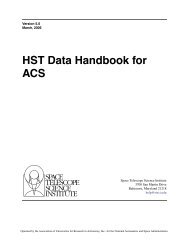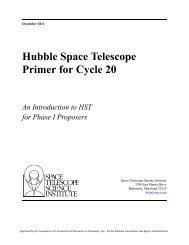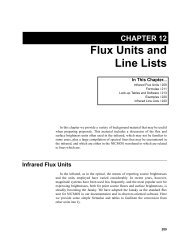Wide Field Camera 3 Instrument Handbook for Cycle 19 - Space ...
Wide Field Camera 3 Instrument Handbook for Cycle 19 - Space ...
Wide Field Camera 3 Instrument Handbook for Cycle 19 - Space ...
Create successful ePaper yourself
Turn your PDF publications into a flip-book with our unique Google optimized e-Paper software.
38 Chapter 5: WFC3 Detector Characteristics and Per<strong>for</strong>mance<br />
5.4.4 Long-Wavelength Fringing<br />
Multiple reflections between the layers of a CCD detector can give rise to fringing,<br />
where the amplitude of the fringes is a strong function of the silicon detector layer<br />
thickness and the spectral energy distribution of the light source. Like most<br />
back-thinned CCDs, the WFC3 CCDs exhibit fringing at wavelengths longward of<br />
~700 nm (see Figure 5.4). The amplitude of the flat-field signal <strong>for</strong> monochromatic<br />
input increases gradually with wavelength and can reach levels of ± 50% at the longest<br />
CCD wavelengths (fringe amplitude is the envelope of the curve shown in Figure 5.5).<br />
An analysis of fringing effects in broadband-illuminated ground flats longward of<br />
600nm (ISR 2010-04) has shown that F953N has the greatest fringe amplitude<br />
(~16%), followed by the quad filters FQ889N, FQ906N, FQ942N, and FQ937N<br />
(~10%). Other narrowband and quad filters have fringe amplitudes in the range of<br />
0.5-4.6% (F656N, F658N, FQ672N, F673N, FQ674N, FQ727N, and FQ750N).<br />
Although fringing is generally weak at wavelengths shorter than 700 nm, the very<br />
narrow H alpha filter (F656N) exhibits a fringe amplitude of up to several percent in<br />
flat fields acquired during ground testing (WFC3 ISRs 2008-17, 2008-46, 2010-04).<br />
Note, however, that the amplitudes of fringing listed here (and in WFC3 ISR<br />
2010-04) should be used only as an estimate of the effect in science data. Fringing will<br />
be different <strong>for</strong> sources with spectral energy distributions (SEDs) which differ<br />
significantly from the calibration lamp used to generate the ground flat fields. For<br />
example, continuum sources in broad filters will effectively smooth out fringing<br />
effects but that same filter can show strong fringes when illuminated by sources with<br />
strong spectral lines or SEDs much narrower than the filter bandpass. Conversely, <strong>for</strong><br />
sources with SEDs similar to the calibration lamp, the fringes can be corrected by the<br />
flat-fielding process.<br />
The fringe pattern has been shown to be very stable, as long as the wavelength of<br />
light on a particular part of the CCD stays constant, so fringing can be corrected if an<br />
appropriate flat field is available. The fringe pattern can also be modeled, either by<br />
interpolating between or combining monochromatic patterns previously obtained in<br />
the laboratory, or from theoretical calculations. For a detailed explanation of ongoing<br />
ef<strong>for</strong>ts to model the WFC3 fringe pattern, see Malumuth et al. (2003, Proceedings of<br />
SPIE 4854, Future EUV/UV and Visible <strong>Space</strong> Astrophysics Missions and<br />
<strong>Instrument</strong>ation, pp. 567–576).<br />
Tools <strong>for</strong> correcting fringing are under development, and will be characterized with<br />
on-orbit cluster photometry. A description of this work (“Fringing in the WFC3/UVIS<br />
detector”) was presented by M. Wong at the 2010 STScI Calibration Workshop.







